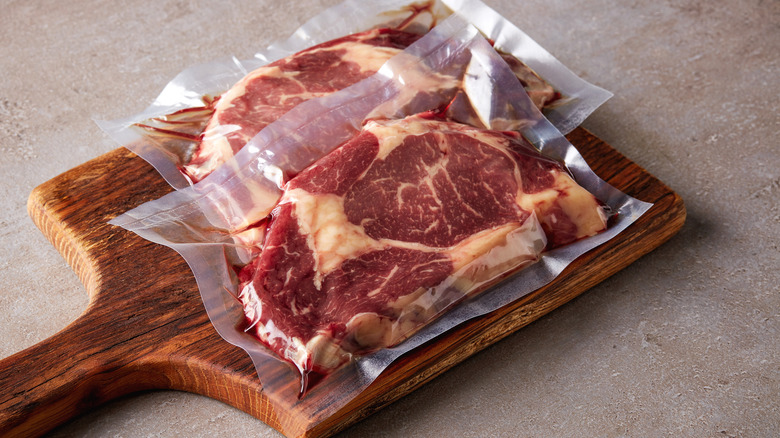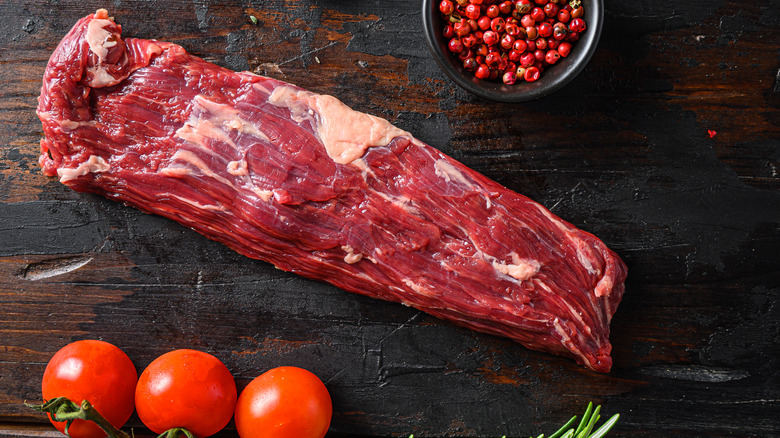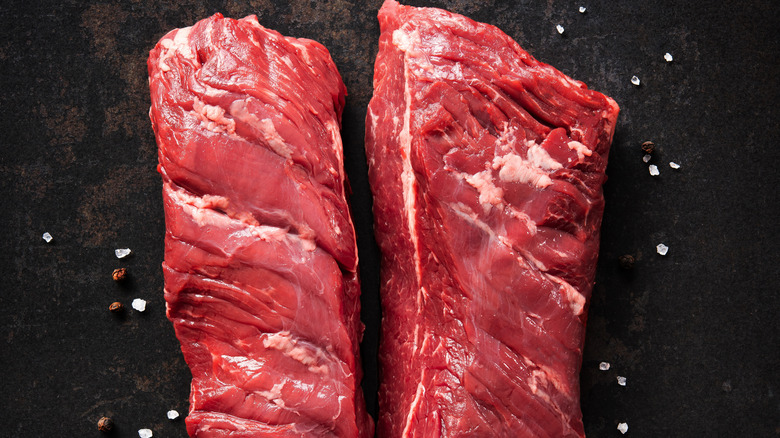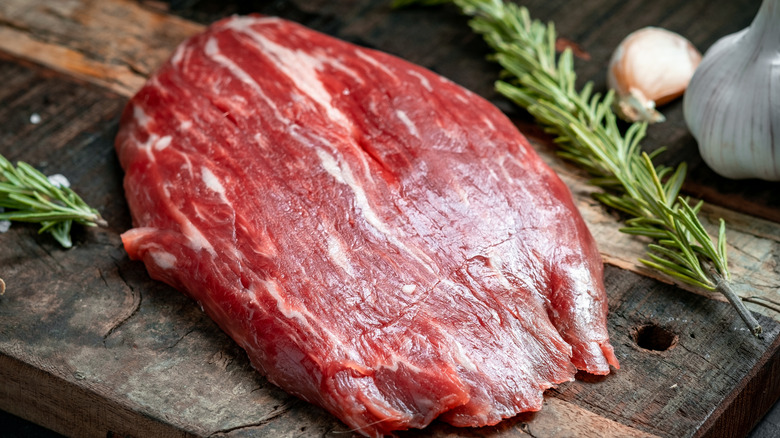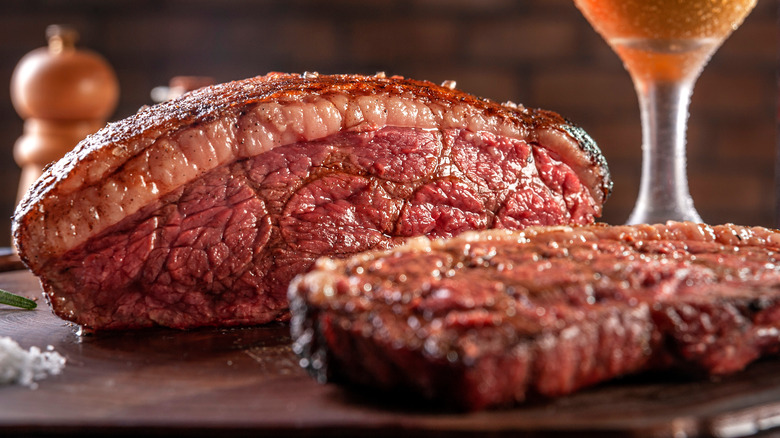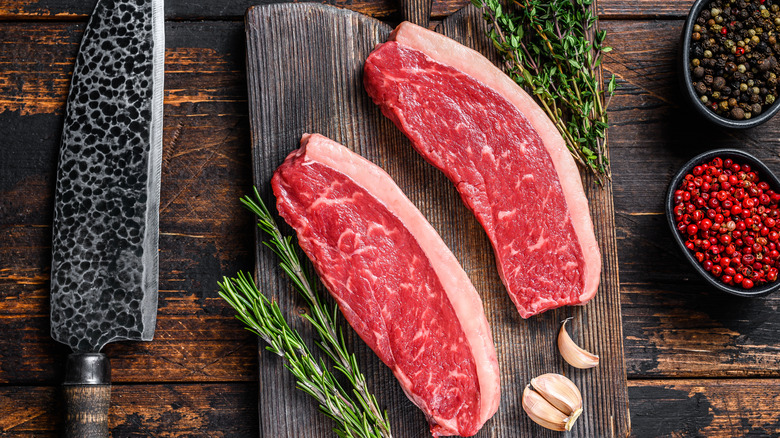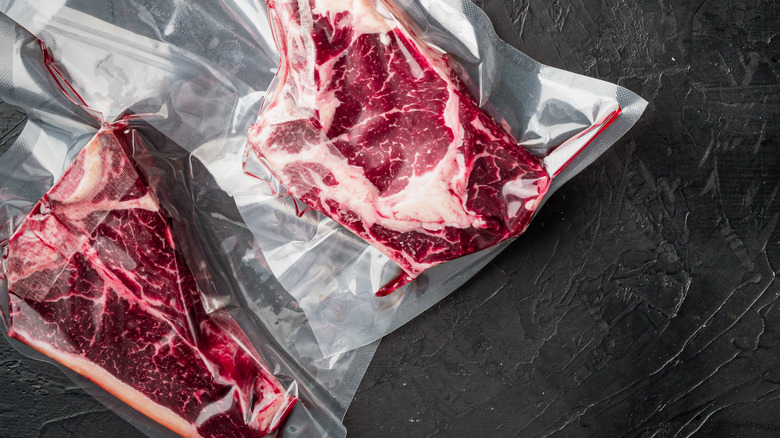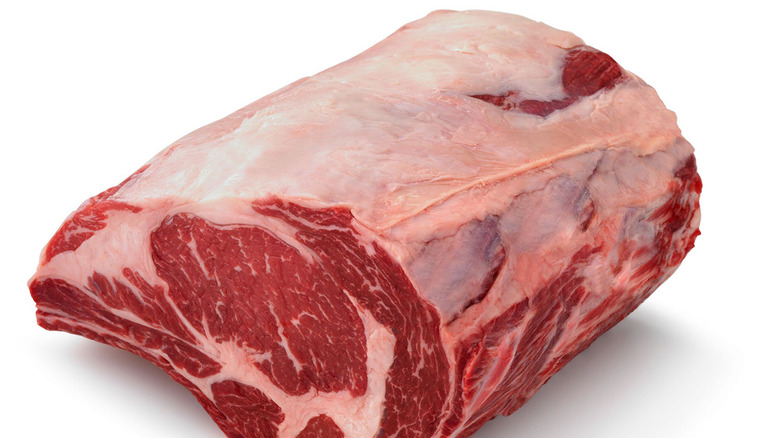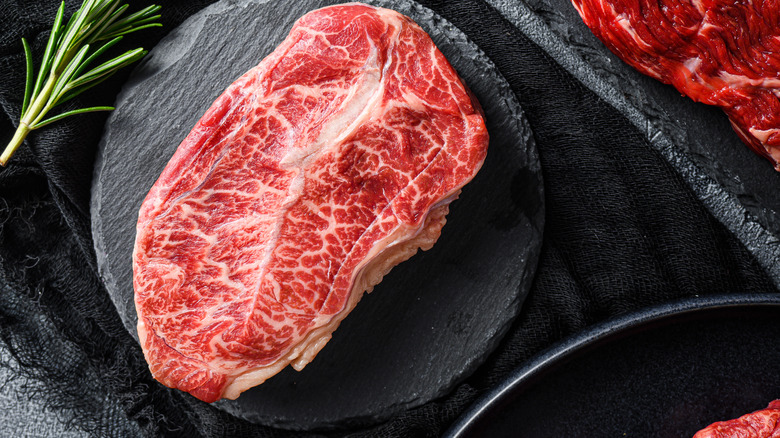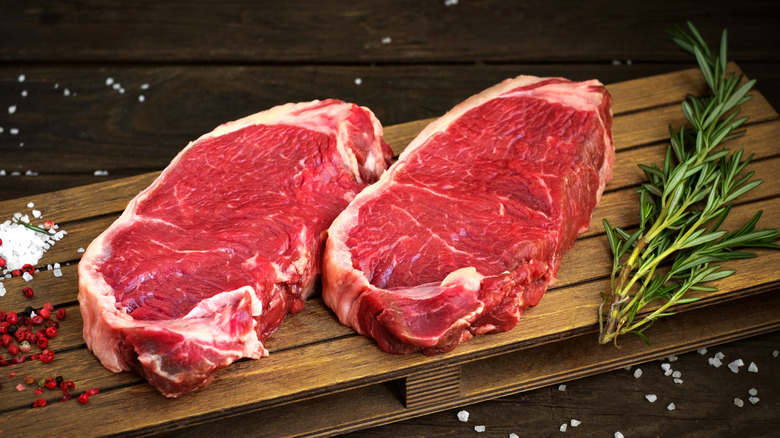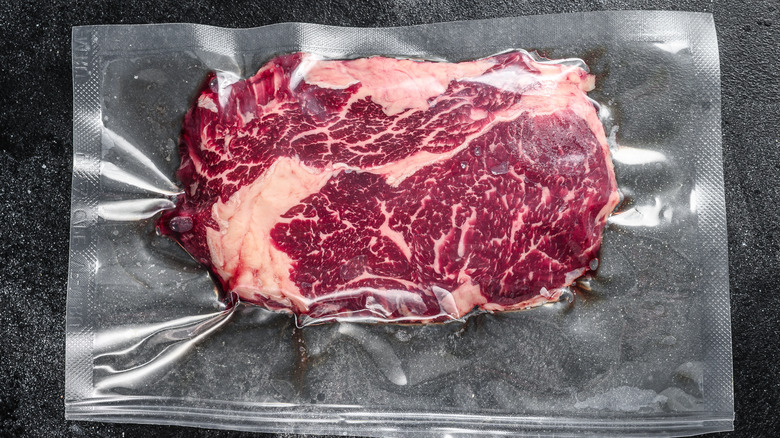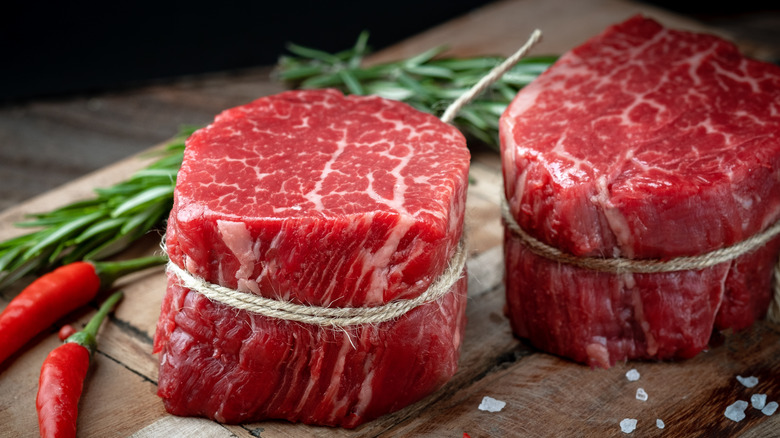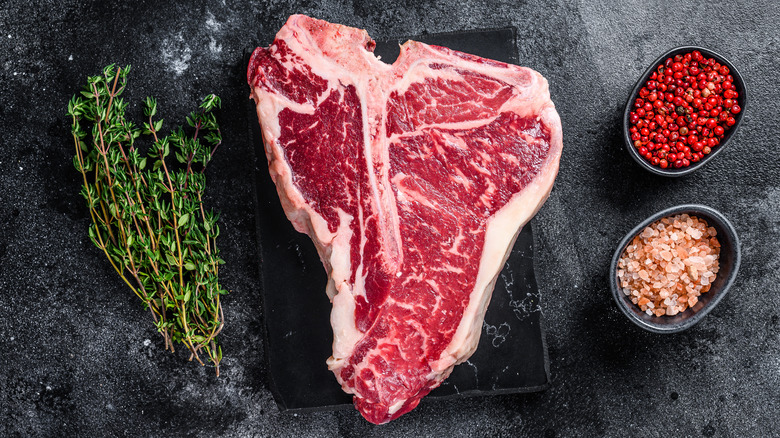Ranking Cuts Of Steak To Sous Vide From Worst To Best
When it comes to irreplaceable kitchen devices of the 21st century, there is a lengthy list of appliances that make the cut, but fewer that fit onto the short list. Whatever your personal rankings, a sous vide machine is at the least an honorable mention, and at best a kitchen essential. As a precise tool that heats and circulates water, the sous vide device is an easy tool to use. Yet, the function is only half of what you need to cook a great dinner; your chosen steak cut is going to have a great effect on how a meal turns out.
Science shows that sous vide cooking has many general effects that are noticeable regardless of the specific cut used (via Cook's Illustrated). For example, by circulating the flow of hot water at a certain temperature, the sous vide technique achieves an extended low-heat state (around 130 degrees Fahrenheit) which activates protein-softening enzymes found in muscles of a cow's body. So no matter where your steak is carved from, this device leverages biology into a perfectly prepared piece of meat. However, while the general effects of tenderizing collagen and retaining moisture are active regardless of the style of steak you're using, some slices remain a cut above the rest.
12. Skirt steak
Serious Eats writes that there are two basic steps to sous vide cooking. The first is the hands-off part of the process when you will vacuum-seal your bag, submerge it in a bath, and allow the sous vide to keep a perfectly regulated temperature for as long as your recipe suggests. The second step is a finishing flourish: This is when you will sear the steak, either on a scalding cast iron pan or on the grill. The food lab at Serious Eats suggests the ideal thickness of steak is around 2 inches. With those points in mind, the skirt steak ranks as one of the worst cuts to sous vide, primarily due to its lack of body.
Skirt steak is by no means small, but it isn't a very voluptuous slice either. Per Cook's Illustrated, the skirt can be around 2 feet in length, though as a flat cut from the diaphragm of a cow, the average steak is around a ½-inch thick. It is also tough without proper marination or when overcooked, which reveals why skirt is the worst steak to sous vide. This cooking method can bring meat to the optimal internal temperature precisely. But, with something as thin as skirt steak, the final sear is nearly guaranteed to take your beef past its prime. You can attempt to get both texture and flavor from sous vide skirt steak, but trying to develop bark without baking the inside to a rubbery finish will add risk and guesswork back into grilling.
11. Hanger
Hanger steak is another slice from the diaphragm, which if you aren't familiar is the area between a cow's rib cage and tenderloin (via Chicago Steak Company). As part of the same grouping as skirt (and flank), hanger is considered a flat steak with a thickness suited for rapid, high-heat grilling. Chicago Steak regards it as the most tender of the group, even suggesting that it can shine as a centerpiece when prepared correctly. The question is: Does sous vide cooking bring out the best in this cut?
Unfortunately, we don't believe so. Although the internet abounds with recipes for sous vide hanger steak, it is a riskier piece to run with if you're looking for a shoo-in, at-home steak house experience. The issue with cooking hanger via sous vide is that the only thing thinner than your steak is the margin for error. As a flat cut, grilling hanger steak already requires dedicated attention as it can go from crisp fatty edging to inedible jerky in a brief moment.
Further, should you choose to skip developing a charred texture on the outside, you may be serving one of the biggest sous vide mistakes. Per Digital Trends, fat takes an extended period to render crispy, meaning that the fat studded throughout a hanger steak can become very chewy without some time on the grill. The sous vide method should make things easier, but this cut has too many variables.
10. Flank
Flank steak is the final diaphragm cut, though it has a few distinctions that make it better for sous vide preparation. There is flank steak's composition, for one. Fine Cooking details the flank steak as leaner than skirt and hanger steaks. This alone does not necessarily solve what you might call the "flat steak" issue, but it does mean that your steak can spend slightly less time on the grill since you're only searing meat and not trying to render fat to a flaky finish. According to this recipe from Tasting Table, sous vide flank steak should blister on the grill for two minutes per side. That should be plenty of time to crust your steak while maintaining a perfectly moist medium, instead of turning it into a garish gray hunk of overcooked tarmac.
Although flank steak can be lean, tough, and fibrous, the science at work in sous vide can break down the muscle fibers and highlight the best parts of this intensely flavorful cut (via Cook's Illustrated). When considering that this is an overall meatier cut than the other diaphragm pieces, the flank steak should be your go-to if looking for a flat steak to sous vide and slice fajita-style.
9. Rump (round)
Here at Mashed, we have said some fairly harsh things about rump steak in the past. And we're not here to recant calling it one of the worst cuts of steak out there, but we would maybe like to add an asterisk. Sous vide cooking gives a new outlook on this ordinarily bland and rough piece of meat, though be warned that the technique isn't a miracle worker.
Great British Chefs explain that the rump steak comes from the hindquarters of a cow, which is an area that experiences a lot of movement. You can expect that a rump steak will have firm, tightly bound muscle and protein fibers, with very little fat at 2 grams per 3-ounce serving (via LiveStrong). According to Cook's Info, you're more likely to find this steak sold as part of a larger cut in America, known as a rump roast, though it is sometimes available as a solo cut in specialty meat markets. If you come across the brawny meat and are feeling up to an inexpensive experiment, know that science is on your side when it comes to cooking it sous vide. Rump roasts are often braised or slow-cooked so that low heat can break down tough muscle threads — which is exactly what sous vide cooking is designed to do (via Cook's Illustrated).
8. Top sirloin
When deciding between one piece versus another for sous vide preparation, consider the marbling and the overall thickness of the slice. Among those qualities that separate the best from the worst sous vide steak cuts, top sirloin steak sits in the middle, if not a bit on the superior side. For starters, top sirloin is definitely a thicker cut of meat — the ideal sirloin to look for is a 1 ½-inch piece — and top sirloin is incredibly lean compared to other steaks. All that is to say, sous vide will tenderize the meat just like it should, without any worries about whether or not there are hidden bits of unrendered gelatinous fat in your next bite.
Home cooks on StackExchange (and science) agree that lean cuts, which don't ordinarily hold the fat to cook tender, have the most to gain by cooking with a method that stresses moisture retention. Top sirloin steak is not as naturally flavorful as, say, ribeye. But, it is economical compared to "premium" cuts and will take weeknight dinner beyond the pale (via Omaha Steaks).
7. Tomahawk
Can you sous vide bone-in meat? It's a common question that regularly bounces around virtual cooking forums, and the answer is simple: Yes, you can absolutely sous vide bone-in meat. As long as your vacuum bag is large enough to fit it, you can basically sous vide anything. With that in mind, you might think that the tomahawk steak, which Ruth's Chris Steak House defines as a bone-in ribeye, would be a great steak to cook with a hot water bath. After all, the tomahawk cut has an excellent distribution of fat to meat, and it averages 2 inches thick (or greater). Plus, cooked meat is often more moist and tender when prepared with the bone (via Serious Eats). Why then, does the tomahawk steak earn a middling rank in terms of sous vide cooking?
In our perspective, it comes down to convenience and ease. Commenters on various Reddit threads and culinary forums for sous vide cooking mention several difficulties and special considerations that bone-in styles (and the tomahawk in particular) require. The large bone — Ruth's Chris sizes it is approximately 5-inches long — can be challenging to submerge, and you might struggle to wrestle the steak flat for an even crust when searing. However, saw the bone off and you risk puncturing the vacuum bag. A torch can cook the outside, but if you don't have that or a grill handy, you could be left unable to fully render the perfect crackling coat to an expensive piece of beef. A lot of work when you could just go for boneless.
6. Prime rib
Tomahawk, ribeye, and prime rib are all steaks that come from the same primal cut that's removed from the rib cage of a cow (via Chicago Steak Company). Unlike the other two butcher favorites, prime rib is more of a standing roast than a traditional steak. As a special occasion meal, prime rib often gets a long, slow roast preparation that preserves juices and fats without drying out the meat. Sous Vide Magazine writes that preparing prime rib via sous vide is an excellent substitution cooking method, thanks to precision temperature management and the fact that you can supposedly cook prime rib in a hot water bath as long as necessary. The publication even recommends preparing this cut via sous vide for up to 24 hours!
If sous vide prime rib sounds like a delicious shortcut to you, then buckle up for a long ride, because it's not all flaky fields of golden charred fat cap. Digital Trends reminds us that two of the biggest mistakes one can make while cooking sous vide are treating fat in the wrong ways, and expecting a sous vide item to taste like the conventionally cooked version. Take that with experiments from the Serious Eats Food Lab that suggest meat loses a significant amount of chew and resistance when cooked for long periods, and preparing a prime rib in the bath begins to feel questionable. Overall, the considerable fat content can become gelatinous and there are easier cuts to cook with this method than bulky prime rib.
5. Flat iron
It may not be the most voluminous cut, but flat iron steak is one of the best pieces to sous vide, thanks to a prime balance of tender muscle meat speckled with rich pieces of fat. Fine Cooking calls this slice — also known as top blade steak — a relatively tender piece of meat. Omaha Steaks goes further, saying the flat iron's downy texture is second only to filet mignon. The flat iron cut is a relatively new butchering move, derived from the shoulder or chuck, once considered unusable due to an intramuscular connective tissue.
According to the Chicago Steak Company, flat iron oozes the characteristic tastes of beef, resulting in a based minerality and natural saltiness when prepared correctly. The sous vide and sear is the way to do it. Per Fine Cooking, a serving of flat iron should be around 1¼- to 1½-inch dense, which is a passable thickness for a steak to endure searing while maintaining a pink interior. Users on the culinary forum Anova propose sous viding a flat iron for around four hours, the end result being a medium steak that should singe for no longer than 1½ minutes on either side.
The flat iron is a great steak to sous vide because of its velvet mouthfeel and intense umami, but its history holds it back. As a newer cut, we find that it's still common to get flat irons with the gristle improperly trimmed, or with the two pieces of flat iron per cow remaining attached to either side of the connective tissue. Other, more traditional steaks come with this issue.
4. New York strip
If a ribeye has too much fat for your sous vide journey, then a New York strip should have just enough. In many circles, the top three-to-four sous vide steaks are interchangeable, yet we are in the camp that says the New York strip — while good — is just plainly not as great as a ribeye or filet. Yes, New York strip steak is a firm cut that will flourish under the dual cooking of a hot bath and dry searing, but that sturdy structure is a pitfall too. Science from the National Research Council suggests that fat increases our perception of tenderness and taste. Beyond actually keeping your meat moist, the absence of marbling affects how flavorful you feel a cut is.
If you are someone who prefers the moderate, trimmable band of fat in a strip steak over the dense, fat found throughout a ribeye, (per Grill Masters University), then ignore this ranking completely. However, if you've long noticed the connection between fat and flavor in your own mind and taste buds, recognize this too: Sous vide New York strip is fine, but your at-home steak dreams can get better.
3. Ribeye
In the end, things begin to get hazy when deciding the "best" cuts of steak to sous vide. The differences depend more on personal preference than any sort of scientific analysis. Still, there remain some small aspects that definitively shape the decision process. The ever-important fat content of a ribeye is one in particular.
Per VeryWellFit, ribeyes have a more marbling, which Men's Health translates to meaning greater durability against overcooking when exposed to increased heat. Searing should be the only part of sous vide cooking that requires high temperatures. But between the ample fat distribution in ribeye meat and the optimal width of the cut, ribeyes can easily render into a buttery yet textured coating whether finishing on the grill, under a broiler, or in a pan. Nevertheless, cooking ribeye steak via sous vide demands some of the same deliberations as with other lard-laden cuts (prime rib, skirt steak, etc.); pay attention to whether or not intramuscular fat has become rubbery, chewy, or gelatinous during cooking. While nutritious in its own right, not everyone likes the higher fat content of ribeye steaks, even with the trade off of a grassy, earthen, wholesome flavor. An unpleasant texture can ruin your meal.
2. Filet mignon
While working with meats in the Food Lab, Serious Eats discovered the optimal thickness for sous vide steak cut is around 2 inches. That said, perhaps it's no coincidence that Delishably reports the average filet mignon piece ranges from 1½ to 3 inches, the optimal size to undergo what we might dub the "bath and blister" cooking method. What makes this butcher's piece one of the best steaks to treat with an immersion circulator? With filet mignon, it is less about the taste and more about the melting, unctuous texture (via Chicago Steak Company). To be honest, it's still about the taste too.
As we've reported before at Mashed, there is a right way to cook filet mignon with conventional methods, and fortunately, our tips track for sous vide cooking too. The best way to maintain the decadent mouthfeel of the filet is to maintain as much moisture inside the meat as possible. This looks like a pre-sear when dry cooking, but when making a filet with hot water, the sous vide is already at work keeping juices locked in your cut (Cook's Illustrated). Despite having some of the smallest amounts of fat within it, lean filet meat has an incomparable buttery softness that thrives when cooked at a precisely regulated temperature.
1. Porterhouse
When we first started sous vide cooking, the process was exciting. It's still exciting, only a little more ordinary. Our novelty of watching hot water (the antithesis of a grill) precisely cook a steak has been replaced with benign awe for the real purpose of an immersion circulator: It frees our hands to tackle several kitchen chores at once. The true value of the cooking method is its convenience, so it makes sense that the best steak cut to sous vide is one that's just as efficient: the porterhouse.
The porterhouse steak, which comes from the short loin of a cow, is like having two steaks in one. That's because it's a cut that joins strip steak with filet mignon (via Chicago Steak Company). This makes the porterhouse a prime steak to sous vide. Not only is this cut two different styles of steak in one, but it is two of the best cuts of steak in one. Chicago Steak clarifies that in order to be considered a porterhouse (instead of a T-bone) the tenderloin portion must clock at least 1¼-inch thick, giving the porterhouse a reasonable thickness to withstand a long bath sealed with a sear. The cooks among those at Anova culinary forum write that the differences between a filet and a strip mean you will have to prioritize cooking one over the other — temperature and time vary depending if your focus is set to the strip or the filet. Still, with such an abundance of fine meats, we doubt you'll be disappointed with the results.
